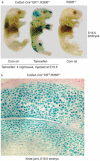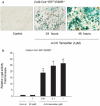Generation of a transgenic mouse model with chondrocyte-specific and tamoxifen-inducible expression of Cre recombinase
- PMID: 17211877
- PMCID: PMC2654410
- DOI: 10.1002/dvg.20261
Generation of a transgenic mouse model with chondrocyte-specific and tamoxifen-inducible expression of Cre recombinase
Abstract
Postnatal cartilage development and growth are regulated by key growth factors and signaling molecules. To fully understand the function of these regulators, an inducible and chondrocyte-specific gene deletion system needs to be established to circumvent the perinatal lethality. In this report, we have generated a transgenic mouse model (Col2a1-CreER(T2)) in which expression of the Cre recombinase is driven by the chondrocyte-specific col2a1 promoter in a tamoxifen-inducible manner. To determine the specificity and efficiency of the Cre recombination, we have bred Col2a1-CreER(T2) mice with Rosa26R reporter mice. The X-Gal staining showed that the Cre recombination is specifically achieved in cartilage tissues with tamoxifen-induction. In vitro experiments of chondrocyte cell culture also demonstrate the 4-hydroxy tamoxifen-induced Cre recombination. These results demonstrate that Col2a1-CreER(T2) transgenic mice can be used as a valuable tool for an inducible and chondrocyte-specific gene deletion approach.
Figures





Similar articles
-
Tamoxifen-inducible Cre-recombination in articular chondrocytes of adult Col2a1-CreER(T2) transgenic mice.Osteoarthritis Cartilage. 2008 Jan;16(1):129-30. doi: 10.1016/j.joca.2007.08.001. Epub 2007 Sep 20. Osteoarthritis Cartilage. 2008. PMID: 17888690 Free PMC article.
-
A mouse model with tamoxifen-inducible thyrocyte-specific cre recombinase activity.Genesis. 2014 Apr;52(4):333-40. doi: 10.1002/dvg.22740. Epub 2014 Jan 15. Genesis. 2014. PMID: 24395757
-
Generation of a mouse line harboring a Bi-transgene expressing luciferase and tamoxifen-activatable creER(T2) recombinase in cartilage.Genesis. 2014 Feb;52(2):110-9. doi: 10.1002/dvg.22734. Epub 2013 Dec 27. Genesis. 2014. PMID: 24339176
-
Col2CreER(T2), a mouse model for a chondrocyte-specific and inducible gene deletion.Eur Cell Mater. 2014 Oct 23;28:236-45. doi: 10.22203/ecm.v028a16. Eur Cell Mater. 2014. PMID: 25340803 Free PMC article. Review.
-
How to build an inducible cartilage-specific transgenic mouse.Arthritis Res Ther. 2014;16(3):210. doi: 10.1186/ar4573. Arthritis Res Ther. 2014. PMID: 25166474 Free PMC article. Review.
Cited by
-
Chondrocytic Atf4 regulates osteoblast differentiation and function via Ihh.Development. 2012 Feb;139(3):601-11. doi: 10.1242/dev.069575. Epub 2011 Dec 21. Development. 2012. PMID: 22190639 Free PMC article.
-
Tgfbr2 is required in Acan-expressing cells for maintenance of the intervertebral and sternocostal joints.JOR Spine. 2018 Jun;1(2):e1025. doi: 10.1002/jsp2.1025. Epub 2018 Jun 22. JOR Spine. 2018. PMID: 30662980 Free PMC article.
-
Inhibition of beta-catenin signaling in articular chondrocytes results in articular cartilage destruction.Arthritis Rheum. 2008 Jul;58(7):2053-64. doi: 10.1002/art.23614. Arthritis Rheum. 2008. PMID: 18576323 Free PMC article.
-
Tamoxifen-inducible podocyte-specific iCre recombinase transgenic mouse provides a simple approach for modulation of podocytes in vivo.Genesis. 2010 Jul;48(7):446-51. doi: 10.1002/dvg.20635. Genesis. 2010. PMID: 20641128 Free PMC article.
-
Cartilage-specific RBPjκ-dependent and -independent Notch signals regulate cartilage and bone development.Development. 2012 Mar;139(6):1198-212. doi: 10.1242/dev.070649. Development. 2012. PMID: 22354840 Free PMC article.
References
-
- Feil R, Wagner J, Metzger D, Chambon P. Regulation of Cre recombinase activity by mutated estrogen receptor ligand-binding domains. Biochem Biophys Res Commun. 1997;237:752–757. - PubMed
-
- Grover J, Roughley PJ. Generation of a transgenic mouse in which Cre recombinase is expressed under control of the type II collagen promoter and doxycycline administration. Matrix Biol. 2006;25:158–165. - PubMed
-
- Hayashi S, McMahon AP. Efficient recombination in diverse tissues by a tamoxifen-inducible form of Cre: A tool for temporally regulated gene activation/inactivation in the mouse. Dev Biol. 2002;244:305–318. - PubMed
-
- Indra AK, Warot X, Brocard J, Bornert JM, Xiao JH, Chambon P, Metzger D. Temporally-controlled site-specific mutagenesis in the basal layer of the epidermis: Comparison of the recombinase activity of the tamoxifen-inducible Cre-ER(T) and Cre-ER(T2) recombinases. Nucleic Acids Res. 1999;27:4324–4327. - PMC - PubMed
Publication types
MeSH terms
Substances
Grants and funding
LinkOut - more resources
Full Text Sources
Other Literature Sources
Molecular Biology Databases

